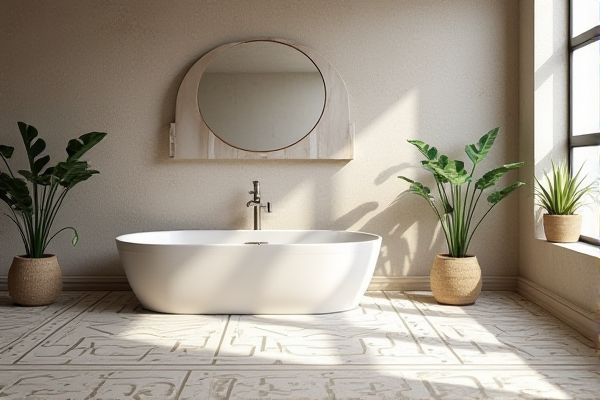
Patterned tiles add visual interest and personality to spaces, creating dynamic and unique designs, while plain tiles offer a minimalist, versatile backdrop that can easily complement various decor styles. Explore the rest of the article to discover which tile style best suits your space and personal taste.
Table of Comparison
| Feature | Patterned Tile | Plain Tile |
|---|---|---|
| Design | Intricate designs and motifs | Solid colors, simple appearance |
| Visual Impact | Bold, decorative, focal point | Minimalistic, subtle, versatile |
| Use Cases | Accent walls, feature floors, backsplashes | Flooring, walls, large surface areas |
| Installation | Requires pattern alignment, careful planning | Simple, quick, fewer placement concerns |
| Cost | Generally higher due to design complexity | Usually lower, budget-friendly |
| Maintenance | Shows less dirt due to designs | Shows stains more easily, easier cleaning |
| Style Compatibility | Traditional, eclectic, vintage, artistic | Modern, minimalist, contemporary |
Introduction to Patterned vs Plain Tiles
Patterned tiles offer intricate designs that add visual interest and character to any space, making them ideal for creating focal points or artistic statements. Plain tiles provide a versatile and timeless backdrop, perfect for minimalist or modern aesthetics, allowing for easy coordination with various decor styles. Your choice between patterned and plain tiles depends on the desired ambiance and how much emphasis you want to place on tile design within your interior.
Aesthetic Appeal: Patterned Tile vs Plain Tile
Patterned tiles offer dynamic visual interest and intricate designs that create focal points and enhance the character of any space, making them ideal for feature walls and decorative accents. Plain tiles provide a clean, minimalist look that fosters versatility and timeless elegance, allowing easy coordination with various decor styles and color schemes. Selecting between patterned and plain tiles depends on the desired aesthetic impact and overall design harmony within the environment.
Design Versatility and Style Options
Patterned tiles offer extensive design versatility by incorporating intricate motifs and vibrant colors that can create unique focal points or complement various interior themes. Plain tiles provide a timeless, minimalist aesthetic that easily adapts to different styles, serving as a versatile backdrop or foundation for bold decor elements. Your choice between patterned and plain tiles will depend on whether you want a statement piece that adds character or a subtle surface that enhances other design features.
Visual Impact and Room Perception
Patterned tiles create a dynamic visual impact by adding texture, color, and intricate designs that draw the eye and make spaces feel lively and personalized. In contrast, plain tiles offer a clean, minimalist look that can make rooms appear larger and more open due to their uniform surface and reflective qualities. Both options influence room perception, with patterned tiles enhancing depth and personality, while plain tiles promote simplicity and spatial expansion.
Cost Comparison: Investment and Value
Patterned tiles often have a higher upfront cost compared to plain tiles due to intricate designs and specialized manufacturing processes. Your investment in patterned tiles can add significant visual appeal and potentially increase property value, making them a worthwhile choice for feature areas. Plain tiles typically offer a more budget-friendly option with versatile use and easier replacement costs, balancing economic efficiency with design flexibility.
Installation Process and Considerations
Patterned tile installation requires precise alignment and careful planning to maintain the design's continuity, often demanding more time and skill compared to plain tile. Grout color selection and tile orientation are critical to enhance the pattern's visual impact and prevent misalignment issues. Your choice between patterned and plain tile should factor in installation complexity and the potential need for experienced professionals to ensure a flawless finish.
Maintenance and Cleaning Differences
Patterned tiles require more frequent and careful cleaning to prevent dirt buildup in grooves and intricate designs, while plain tiles offer a smoother surface that is easier to wipe and maintain. The grout lines on patterned tiles can accumulate grime faster, necessitating specialized cleaning products or tools to preserve their appearance. Plain tiles typically allow for quicker maintenance routines, reducing time spent on scrubbing and minimizing the risk of staining.
Durability and Longevity
Patterned tiles often feature multiple layers of glaze that enhance resistance to scratches and wear, contributing to superior durability compared to many plain tiles. High-quality porcelain patterned tiles typically offer exceptional longevity, maintaining their visual appeal and structural integrity for decades under heavy foot traffic. Plain tiles, while durable, may show signs of fading or surface damage more readily, especially if they lack protective coatings or are made from softer materials.
Best Applications and Room Suitability
Patterned tiles excel in spaces like kitchens and bathrooms, where they add visual interest and create focal points on backsplashes or accent walls. Plain tiles work well in larger areas such as living rooms or hallways, providing a neutral backdrop that enhances furniture and decor. Combining patterned tiles in smaller zones with plain tiles in broader spaces balances vibrancy and subtlety for optimal room suitability.
Choosing the Right Tile for Your Space
Patterned tiles add visual interest and personality to spaces like kitchens, bathrooms, and accent walls, creating focal points with intricate designs and vibrant colors. Plain tiles offer versatility and a clean, timeless look, making them ideal for minimalist or modern interiors where subtlety and uniformity are desired. Selecting the right tile depends on the room's style, size, and intended ambiance, balancing decorative impact with ease of maintenance and overall design cohesion.
 homyna.com
homyna.com